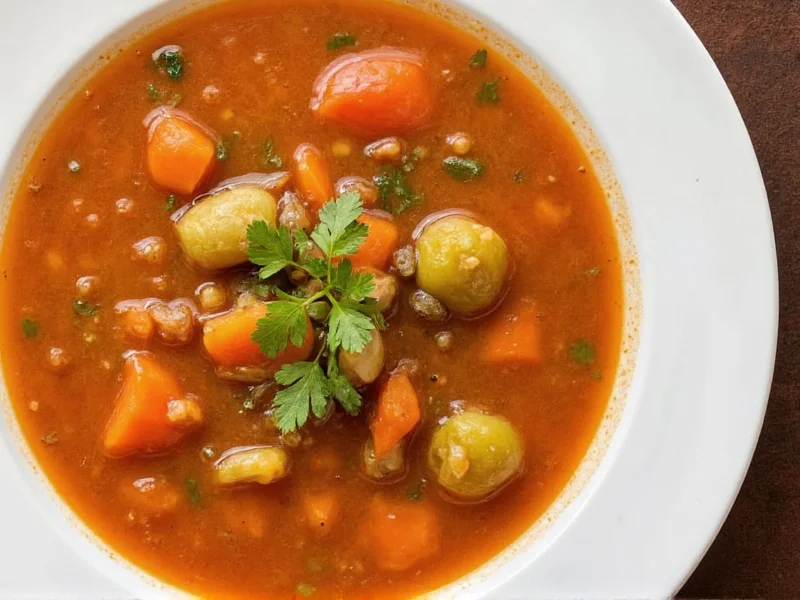The Essential Components of Perfect Homemade Veggie Soup
Creating exceptional homemade veggie soup starts with understanding the foundational elements that transform ordinary vegetables into a deeply flavorful meal. Unlike store-bought alternatives, scratch-made vegetable soup allows complete control over ingredients and seasoning, resulting in a fresher, more vibrant dish that satisfies both taste and nutrition requirements.
Core Vegetable Selection for Flavorful Results
The best homemade vegetable soup balances sweet, savory, and earthy notes through strategic vegetable pairing. Begin with the "holy trinity" of mirepoix: onions, carrots, and celery. These foundational vegetables create depth when sautéed in olive oil until translucent. Add garlic during the last minute of cooking to prevent burning. For sweetness, include diced tomatoes or a small amount of tomato paste. Root vegetables like potatoes or sweet potatoes add heartiness, while leafy greens such as kale or spinach provide color and nutrients in the final minutes of cooking.
| Vegetable Type | Preparation Method | Addition Timing |
|---|---|---|
| Aromatic base (onions, carrots, celery) | Diced 1/4 inch | Start of cooking |
| Garlic | Minced | Last minute of sautéing |
| Tomatoes | Diced or paste | After aromatics soften |
| Root vegetables | Cubed 1/2 inch | With broth |
| Leafy greens | Chopped | Final 5 minutes |
Step-by-Step Preparation Guide
Follow this professional technique for restaurant-quality homemade vegetable soup:
- Sauté aromatics: Heat 2 tablespoons olive oil in a large pot over medium heat. Add 1 diced onion, 2 chopped carrots, and 2 diced celery stalks. Cook 8-10 minutes until softened.
- Add flavor builders: Stir in 3 minced garlic cloves and 1 tablespoon tomato paste. Cook 1 minute until fragrant.
- Build broth foundation: Pour in 6 cups quality vegetable broth and 1 (14oz) can diced tomatoes with juices.
- Add hearty vegetables: Include 2 diced potatoes, 1 chopped zucchini, and 1 cup green beans. Bring to gentle boil.
- Simmer to perfection: Reduce heat to low, cover partially, and simmer 25-30 minutes until vegetables are tender but not mushy.
- Finish with greens: Stir in 2 cups chopped kale or spinach during final 5 minutes of cooking.
- Season thoughtfully: Add salt, pepper, 1 teaspoon dried thyme, and 1 bay leaf during cooking. Finish with fresh parsley.
Advanced Techniques for Enhanced Flavor
Professional chefs use these methods to elevate basic vegetable soup:
- Deglaze the pot: After sautéing vegetables, add 1/4 cup dry white wine or additional broth to scrape up flavorful browned bits from the bottom of the pot.
- Layer seasonings: Add dried herbs at the beginning of cooking and fresh herbs at the end for complex flavor development.
- Create umami depth: Include 1-2 dried shiitake mushrooms or 1 tablespoon nutritional yeast for savory richness without meat.
- Texture variation: Reserve 1 cup of cooked vegetables, puree the rest, then combine for creamy yet chunky consistency.
Customization Options for Dietary Preferences
Adapt your homemade veggie soup to accommodate various dietary needs:
- Gluten-free: Use certified gluten-free broth and avoid adding flour-based thickeners
- Vegan: Ensure broth contains no animal products and skip dairy garnishes
- Low-sodium: Use low-sodium broth and enhance flavor with extra herbs and lemon juice
- Protein boost: Add 1 cup cooked lentils, white beans, or chickpeas during final 10 minutes
Storage and Reheating Best Practices
Homemade vegetable soup maintains quality when stored properly:
- Cool soup completely before refrigerating to prevent condensation
- Store in airtight containers for up to 5 days in the refrigerator
- Freeze in portion-sized containers for up to 3 months
- Reheat gently on stove over medium-low heat, adding small amounts of broth if needed
- Never boil reheated soup vigorously as this breaks down vegetable texture
Nutritional Benefits of Vegetable Soup
A single serving of well-prepared homemade veggie soup delivers significant health advantages. This easy homemade vegetable soup recipe provides approximately 150-200 calories per bowl, depending on ingredients. The combination of diverse vegetables ensures a broad spectrum of vitamins, minerals, and dietary fiber. Regular consumption supports digestive health through soluble and insoluble fiber, while the high water content promotes hydration. Unlike canned alternatives, scratch-made vegetable soup contains no preservatives or excessive sodium, making it an ideal component of balanced meal planning.
Common Mistakes to Avoid
Prevent these frequent errors when preparing vegetable soup from scratch:
- Overcooking vegetables: Add delicate vegetables like zucchini and greens late in the process to maintain texture
- Insufficient seasoning: Season in layers throughout cooking, not just at the end
- Rushing the sauté: Properly cooking the aromatic base develops flavor complexity
- Using poor quality broth: Homemade or high-quality store-bought broth makes a significant difference
- Skipping acid balance: Finish with lemon juice or vinegar to brighten flavors
Seasonal Adaptation Strategies
Adjust your vegetable soup ingredients based on seasonal availability for optimal freshness and flavor. During spring, incorporate asparagus, peas, and fresh herbs. Summer brings tomatoes, zucchini, and bell peppers at their peak. Fall offers butternut squash, sweet potatoes, and hearty greens. Winter soup benefits from root vegetables, cabbage, and kale. This approach to seasonal vegetable soup preparation ensures the most flavorful results while supporting local agriculture and reducing environmental impact.











 浙公网安备
33010002000092号
浙公网安备
33010002000092号 浙B2-20120091-4
浙B2-20120091-4